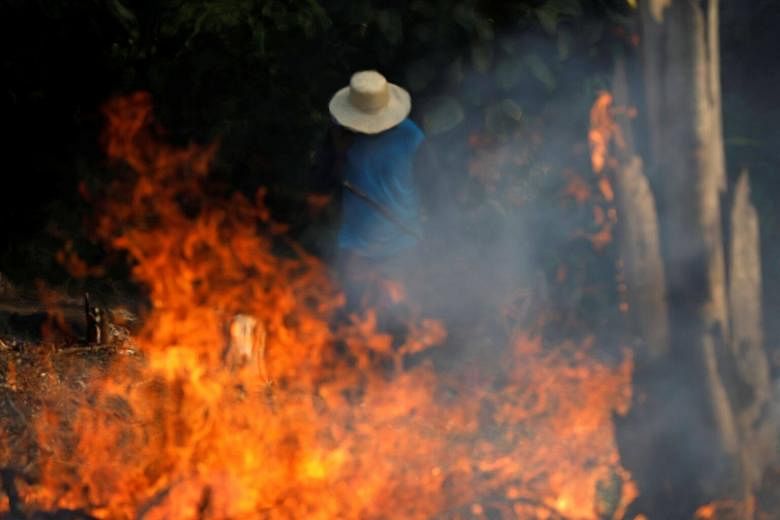RIO DE JANEIRO (NYTIMES) - Fires are burning in the Amazon rainforest at one of the fastest paces in years, Brazil's space research centre said this week.
The centre, the National Institute for Space Research, which monitors fires using satellite images, reported on Wednesday (Aug 21) that it had detected 75,336 fires this year in the world's largest rainforest, an increase of about 80 per cent from the same period in 2018.
The fires, most of which have been set by farmers clearing their land, are raging in uninhabited areas of rainforest and intruding on populated areas in the country's north, including the states of Rondonia and Acre.
The blazes are so large and widespread that smoke has wafted thousands of miles away to the Atlantic coast and Sao Paulo, the country's most populous city, according to the World Meteorological Organisation.
Widely shared photos on social media showed darkened skies over Sao Paulo during the daytime, but researchers said they were working to understand whether that was connected to the fires.
On Wednesday, Brazil's far-right president, Mr Jair Bolsonaro, accused non-governmental organisations of setting the fires in the rainforest after the government pulled their funding, although he presented no evidence.
"It could be, it could; I'm not saying it is, a criminal action by these NGO people to call attention against me, against the Brazilian government," he said. "This is the war we face." He said the government was working to control the blazes.
Researchers, environmentalists and former government officials have been alarmed by the destruction of the Amazon rainforest, which is one of the world's most important natural resources and plays a vital role in absorbing carbon dioxide as global warming advances.
Deforestation of the Amazon has increased rapidly since Mr Bolsonaro, who was elected in October, took office and his government cut back on efforts to confront illegal activity in the rainforest.
Critics say Mr Bolsonaro's policies have emboldened loggers, farmers and miners who want to clear out land illegally.
Ms Mikaela Weisse, a manager of Global Forest Watch, a programme for the environmental research group World Resources Institute, said the rate in the number of fires detected by satellite images this year was roughly comparable to 2016.
"It is definitely something to be concerned about, especially with more research coming out about reaching a tipping point," she said, referring to the point at which parts of the Amazon would no longer have forests and turn to savanna.
The fires burning now are mostly happening in previously deforested areas, most likely related to agricultural practices, she said.
"Natural fires are very rare in the Amazon, so all, or almost all, the fires we are seeing are set by humans," Ms Weisse said.
This month, a local newspaper in the Amazonian state of Para, Folha do Progresso, announced that local farmers were planning a "Day of Fire" in August. Increases in the number of fires were recorded days later.
Local newspapers also reported that states in the Amazon were trying to respond to a crisis. In Amazonas, a crisis Cabinet was set up, and in Acre, the governor declared a state of environmental alert to stop the fires because the air pollution could present a serious health hazard.
Professor Henrique Barbosa, at the University of Sao Paulo and part of the Physics Institute's Atmospheric Physics Laboratory, said that the number of fires in the Amazon had risen during the past two presidential administrations but that they got worse this year.
He said the fires were a marker of the final stage of deforestation, in which trees are cut down for market and then loggers and farmers burn the rest.
Ms Ane Alencar, science director at the Amazon Environmental Research Institute in Brazil, said she was shocked by the numbers, especially because the Amazon is not going through an extreme drought period, as happened from 2014 to 2016 because of El Nino.
The drought period goes from the end of August to November in some states, and it is typically when farmers set fires in the forest to clear out land.
"I'm concerned," Ms Alencar said. "We are at the beginning of the fire season. This could still get much worse.
"What I can say with absolute certainty is that there is a very strong relationship between deforestation and fires," she said. "This isn't a wildfire."
Prof Barbosa and other researchers are now trying to understand if the smoke rising from the fires in the Amazon - or in surrounding areas - had wafted over Sao Paulo, where residents were concerned that the unusual darkness that fell over the city this week was caused by the fires.
"We are trying to understand how much of this black soot was suspended over Sao Paulo," he said.
"In reality, all the signs suggest it will get worse," he added. "There is nothing on the horizon that gives us the tiniest bit of hope something will be done to protect the environment in the next four years."


